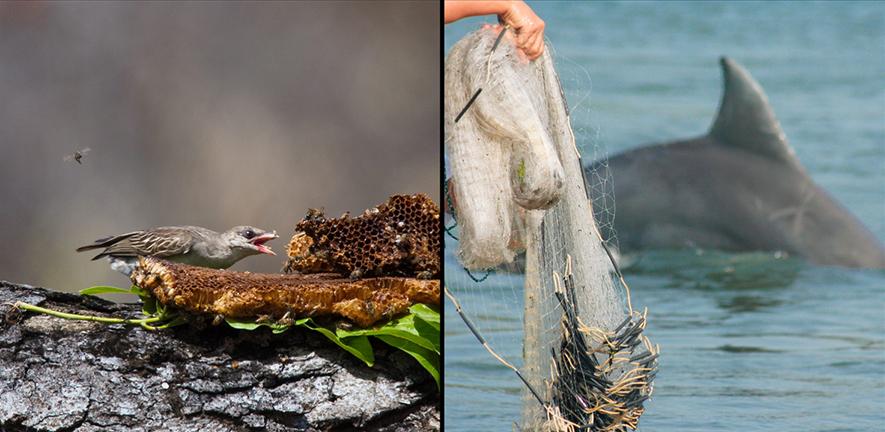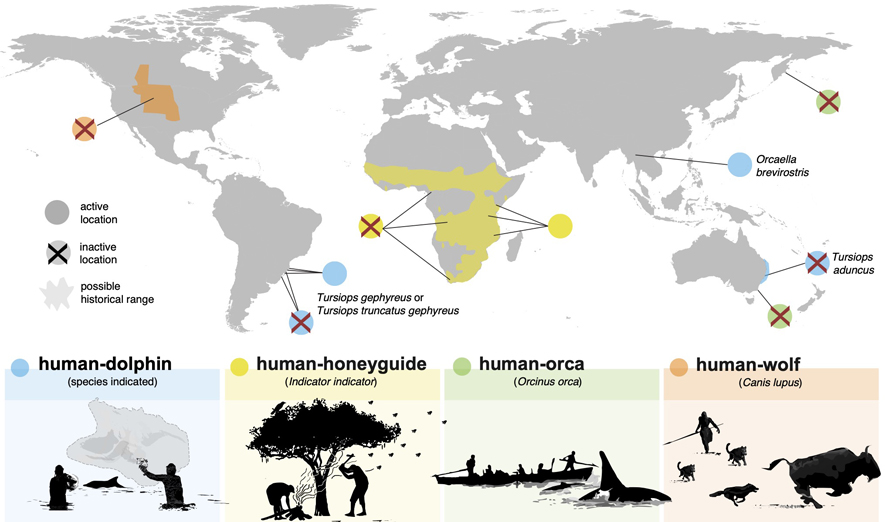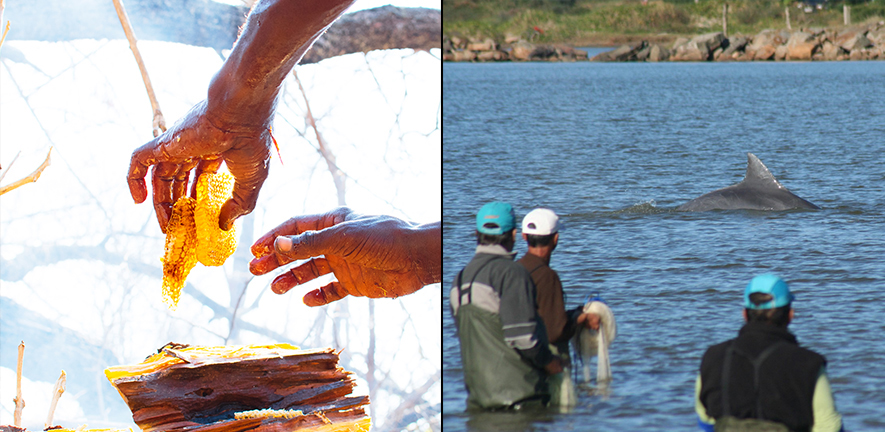
Submitted by Rachel Aucott on Tue, 21/06/2022 - 15:28
Cooperation between humans and wild animals
People cooperate with many species of animals, such as falcons and sheep-dogs, but most cases involve the human controlling the animal’s actions through domestication and captivity. Sometimes, people and wild animals cooperate without human control and to mutual benefit, but much less is known about these rare cases of ‘human-wildlife cooperation’.
In collaboration with Jessica van der Wal at the University of Cape Town, Dominic Cram and Claire Spottiswoode from the Department of Zoology assembled and led a global consortium of experts, including anthropologists, ecologists, zoologists, linguists, and people who cooperate with wild animals. The team of over 40 co-authors (including departmental PhD students Tanmay Dixit, Mairenn Attwood, and Jess Lund) recently published two review papers about human-wildlife cooperation.
The first, published today in People and Nature [1], details the diversity of human-wildlife cooperation, uncovers how these interactions work, and discusses how the partnerships arose.
Diversity of human-wildlife cooperation
In parts of sub-Saharan Africa, people cooperate with the Greater Honeyguide (Indicator indicator) to find wild bees’ nests, revealing the honey for the humans and the beeswax for these wax-eating birds. In Brazil and Myanmar, fishermen cooperate with local species of dolphin to increase the daily catch for both species. Historically, hunters also cooperated with wild animals, working with orcas to catch whales, and with wolves to catch bison.
Map indicating the locations of active and historical cases of human-wildlife cooperation. Solid dots indicate active locations, crossed dots indicate inactive locations (i.e., where cooperation is currently absent, but there is strong evidence for its presence in the past), and shaded areas indicate possible historical ranges. From [2].
All examples of human-wildlife cooperation involve the animal finding or gathering food, and the human using tools to make it more accessible, allowing both parties to get a bigger meal than they would alone. In some cases, the human and animal communicate whilst cooperating, while in others they coordinate their behaviour by watching each another.
People learn how to cooperate with animals by watching their relatives and friends. In the Lahille’s bottlenose dolphins (Tursiops gephyreus) in Brazil, it is likely that the animals similarly “watch and learn” from each other (known as ‘social learning’). In other cases, including the honeyguides, some of the skills needed to cooperate with humans are instinctive. Social learning appears to lead to more geographically variable interactions which can both spread, or be lost, more quickly than behaviours that are instinctive.
(L) A honey-hunter harvesting honey in Niassa Special Reserve, Mozambique. Photo by Dominic Cram. (R) Fishermen prepare their nets as a Lahille’s bottlenose dolphin herds fish towards them. Photo by Fábio Daura-Jorge.
Human-wildlife cooperation may have evolved from other interactions between humans and wild animals, such as animals scavenging from humans, or humans using the presence of animals as a sign of nearby food. Over time, both parties could benefit by coordinating to achieve their common goal.
Loss of human-wildlife cooperation
The second paper, published in Conservation Letters [2], draws attention to the decline and loss of human-wildlife cooperation. The paper highlights the benefits of these interactions, which provide food security to both parties and have cultural importance. It also highlights how these partnerships are threatened by ecological and cultural change, and that tailored conservation plans will be needed to safeguard them for future generations.
Many examples of human-wildlife cooperation are declining, and much remains to be learned. The authors recommend that future studies consider both the human and animal cultural aspects of the interaction, so we can better understand the diversity of our current and ancestral interactions with the natural world.
These studies were supported by the European Research Council (grant number 725185 HONEYGUIDES-HUMANS to Claire Spottiswoode). For more information about this University of Cambridge-based research project on human-honeyguide mutualism, please see www.AfricanHoneyguides.com.
Adapted from the People and Nature lay summary.
[1] Dominic L. Cram, Jessica E. M. van der Wal, Natalie Uomini, Mauricio Cantor, Anap I. Afan, Mairenn C. Attwood, Jenny Amphaeris, Fatima Balasani, Cameron J. Blair, Judith L. Bronstein, Iahaia O. Buanachique, Rion R. T. Cuthill, Jewel Das, Fábio G. Daura-Jorge, Apurba Deb, Tanmay Dixit, Gcina S. Dlamini, Edmond Dounias, Isa I. Gedi, Martin Gruber, Lilian S. Hoffmann, Tobias Holzlehner, Hussein A. Isack, Eliupendo A. Laltaika, David J. Lloyd-Jones, Jess Lund, Alexandre M. S. Machado, L. Mahadevan, Ignacio B. Moreno, Chima J. Nwaogu, Raymond Pierotti, Seliano A. Rucunua, Wilson F. dos Santos, Nathalia Serpa, Brian D. Smith, Hari Sridhar, Irina Tolkova, Tint Tun, João V. S. Valle-Pereira, Brian M. Wood, Richard W. Wrangham, Claire N. Spottiswoode. The ecology and evolution of human–wildlife cooperation. People and Nature. 2022
[2] Jessica E. M. van der Wal, Claire N. Spottiswoode, Natalie T. Uomini, Mauricio Cantor, Fábio G. Daura-Jorge, Anap I. Afan, Mairenn C. Attwood, Jenny Amphaeris, Fatima Balasani, Colleen M. Begg, Cameron J. Blair, Judith L. Bronstein, Iahaia O. Buanachique, Rion R. T. Cuthill, Jewel Das, Apurba Deb, Tanmay Dixit, Gcina S. Dlamini, Edmond Dounias, Isa I. Gedi, Martin Gruber, Lilian S. Hoffmann, Tobias Holzlehner, Hussein A. Isack, Eliupendo A. Laltaika, David J. Lloyd-Jones, Jess Lund, Alexandre M. S. Machado, L. Mahadevan, Ignacio B. Moreno, Chima J. Nwaogu, Valdomiro L. Pereira, Raymond Pierotti, Seliano A. Rucunua, Wilson F. dos Santos, Nathalia Serpa, Brian D. Smith, Irina Tolkova, Tint Tun, João V. S. Valle-Pereira, Brian M. Wood, Richard W. Wrangham, Dominic L. Cram. Safeguarding human–wildlife cooperation. Conservation Letters. 2022; e12886. https://doi.org/10.1111/conl.12886
Top image: Banner image credit: honeyguide eating wax by Dominic Cram, dolphin and fisherman’s hands with net by Fábio Daura-Jorge


